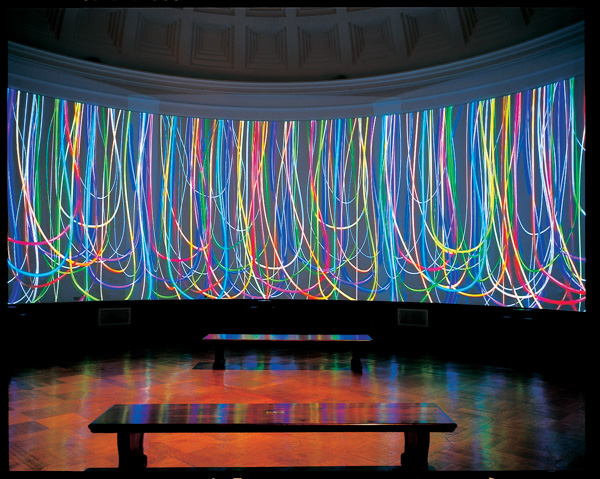By Ruth Steinhardt
The Corcoran School of the Arts and Design at the George Washington University is scheduled to acquire hundreds of pieces from the Corcoran Gallery of Art’s permanent collection, laying the foundation for a research collection that will have significant pedagogical value to Corcoran students and be accessible to faculty, staff and the public.
Particularly notable pieces gifted to GW include Jennifer Steinkamp’s “Loop,” a vibrant audiovisual work once on display in the Corcoran Rotunda; Janet Cardiff and George Bures Miller’s “The Paradise Institute,” an immersive multimedia experience mimicking a grand, old-style movie palace that was created for the 2001 Venice Biennale; and Robert Stackhouse’s colossal wooden “Ghost Dance.” Among the 18 paintings, 642 photos, 93 prints, 15 sculptures and more are works by Ansel Adams, Eugène Delacroix, Sally Mann, Mary Ellen Mark and William Wegman.
“This collection will be used as a dynamic resource for student learning and to generate public discourse on what these objects say about broader issues,” said Corcoran Director Sanjit Sethi. “We’re grateful for the opportunity to give artists, scholars, the D.C. community and the broader public the means to truly immerse themselves in these works more extensively and more regularly than ever before.”
Much of the collection the school will receive is related to the history of the Corcoran and of founder William Wilson Corcoran, including a large oil portrait by William Stone, a series of photographs of the Flagg Building in the 1970s by Paul Kennedy and the original silver and ivory trowel used to lay the landmark building’s cornerstone in the late 19th century.
Corcoran Assistant Director for Academic Affairs Kym Rice said the collection includes “artistic images, pictorials, landscapes, narratives and journalistic works by both artists and photojournalists.”
“So in that sense it really mirrors the breadth of what we teach here,” she said. “There are some very exciting things in it that will be cool for us to have, and more than that it will be a really rich collection for study.”
The collection also gives the Corcoran School an opportunity to expand its display options.
Mr. Sethi hopes to be able to regularly show “The Paradise Institute” annually in the newly renovated Corcoran Rotunda. And the National Gallery of Art, which took custody of the original Corcoran collection, will display some of the works it has acquired in its own “legacy gallery” on the second floor of the Flagg Building.
John Wetenhall, director of the George Washington University Museum and The Textile Museum and associate professor of museum studies, said the collection also opens up new possibilities for curatorial and collection management studies. A new electronic collection management system has the potential to make the entire collection publicly accessible, and students will be involved in transitioning pieces to GW’s state-of-the-art conservation and collections resource center in Ashburn, Va.
“The very intake of this work—storage, cataloguing, registration—is an opportunity for teaching and learning,” Dr. Wetenhall said. “We train a lot of collections managers in this country and around the world, and these Corcoran works enhance our ability to give them a hands-on look at the mechanics of museums.”
Mr. Sethi also hopes the new collection will enable interdisciplinary collaboration by students and faculty not just within the Corcoran School but across GW, “from American Studies to anthropology and beyond.” The university’s other art venues, including the museum and the Luther W. Brady Art Gallery, will have the opportunity for collaborative exhibits, while academic departments will be able to use the pieces as archival and teaching resources.
As the collection is integrated into the Corcoran School, Mr. Sethi says, the focus will be on ensuring student and faculty access to it, whether in the form of faculty exhibitions on campus, digital resources or class visits to the Ashburn facility.
Harry Hopper, chair of the Trustees of the Corcoran Gallery of Art, said the new works of art mark the beginning of a new phase in the Corcoran legacy.
“We are extremely pleased to distribute the Corcoran collection to so many worthy institutions across the city,” he said. “More people will now be able to see and study the art than would have ever been possible at the Corcoran Gallery alone.”



